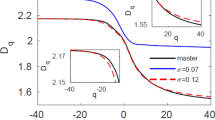Abstract
SUSTAINED nonequiibrium systems can be characterized by a fractal dimension D⩾0, which can be considered to be a measure of the number of independent degrees of freedom1. The dimension D is usually estimated from time series2 but the available algorithms are unreliable and difficult to apply when D is larger than about 5 (refs 3,4). Recent advances in experimental technique5–8 and in parallel computing have now made possible the study of big systems with large fractal dimensions, raising new questions about what physical properties determine D and whether these physical properties can be used in place of time-series to estimate large fractal dimensions. Numerical simulations9–11 suggest that sufficiently large homogeneous systems will generally be extensively chaotic12, which means that D increases linearly with the system volume V. Here we test an hypothesis that follows from this observation: that the fractal dimension of extensive chaos is determined by the average spatial disorder as measured by the spatial correlation length ε associated with the equal-time two-point correlation function —a measure of the correlations between different regions of the system. We find that the hypothesis fails for a representative spatiotemporal chaotic system. Thus, if there is a length scale that characterizes homogeneous extensive chaos, it is not the characteristic length scale of spatial disorder.
This is a preview of subscription content, access via your institution
Access options
Subscribe to this journal
Receive 51 print issues and online access
$199.00 per year
only $3.90 per issue
Buy this article
- Purchase on Springer Link
- Instant access to full article PDF
Prices may be subject to local taxes which are calculated during checkout
Similar content being viewed by others
References
Eckmann, J.-P. & Ruelle, D. Rev. mod. Phys. 57, 617–656 (1985).
Casdagli, M. et al. in Applied Chaos (eds Kim, J. H. & Stringer, J.) 335–380 (Wiley, Boston, 1992).
Ruelle, D. Proc. R. Soc. A427, 241–248 (1990).
Lorenz, E. N. Nature 353, 241–243 (1991).
Assenheimer, M. & Steinberg, V. Nature 367, 345–347 (1994).
Gollub, J. P. & Ramshanker, R. in New Perspectives in Turbulence (eds Orszag, S. & Sirovich, L.) 165–194 (Springer, Berlin, 1990).
Ouyang, Q. & Swinney, H. L. Chaos 1, 411–420 (1991).
Arecchi, F. T. et al. Physica D61, 25–39 (1992).
Manneville, P., Liapunov Exponents for the Kuramoto-Sivashinsky Model, 319–326 (Lecture Notes in Physics Vol. 230, Springer, Berlin, 1985).
Grassberger, P. Physica Scripta 40, 346–353 (1989).
Sirovich, L., Rodriguez, J. D. & Knight, B. Physica D43, 63–76 (1990).
Cross, M. C. & Hohenberg, P. C. Rev. mod. Phys. 65, 851–1112 (1993).
Ruelle, D. Commun. math. Phys. 87, 287–302 (1982).
Bayly, P. V. et al. J. cardiovasc. Electrophysiol. 4, 533–546 (1993).
Kaplan, D. & Cohen, R. Circulation Res. 67, 886–892 (1990).
Bhagavatula, R., Grinstein, G., He, Y. & Jayaprakash, C. Phys. Rev. Lett. 69, 3483–3486 (1992).
Torcini, A., Politi, A., Puccioni, G. P. & D'Alessandro, G. Physica D53, 85–101 (1991).
Glazier, J. A., Kolodner, P. & Williams, H. J. statist. Phys. 64, 945–960 (1991).
Ning, L. & Ecke, R. E. Phys. Rev. E47, 3326–3333 (1993).
Shraiman, B. I. et al. Physica D57, 241–248 (1992).
Canuto, C., Hussaini, M. Y., Quarteroni, A. & Zang, T. A. Spectral Methods in Fluid Dynamics (Springer, New York, 1988).
Parker, T. S. & Chua, L. O. Practical Numerical Algorithms for Chaotic Systems (Springer, New York, 1989).
Miller, J. & Huse, D. A. Phys. Rev. E48, 2528–2535 (1993).
Author information
Authors and Affiliations
Rights and permissions
About this article
Cite this article
Egolf, D., Greenside, H. Relation between fractal dimension and spatial correlation length for extensive chaos. Nature 369, 129–131 (1994). https://doi.org/10.1038/369129a0
Received:
Accepted:
Issue Date:
DOI: https://doi.org/10.1038/369129a0
This article is cited by
-
Mechanisms of extensive spatiotemporal chaos in Rayleigh–Bénard convection
Nature (2000)
-
Spatiotemporal chaos
Nature (1994)
Comments
By submitting a comment you agree to abide by our Terms and Community Guidelines. If you find something abusive or that does not comply with our terms or guidelines please flag it as inappropriate.



